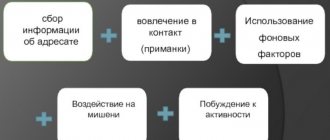Undoubtedly, neurolinguistic programming today is one of the most popular and sought-after ways for a person to influence his own personality and those around him.
After all, NLP allows a person to learn to better understand himself and get rid of any negative traits, while at the same time cultivating positive ones; promotes a deeper understanding of those with whom you interact; makes it possible to make the communication process more pleasant and effective, as well as to influence people of completely different categories.
Moreover, knowledge of NLP is successfully applied not only in psychology, psychotherapy and other related sciences. The use of NLP is ideal for ordinary everyday life. And so that anyone can learn this, there are now many options: video and audio materials, Internet resources, trainings and webinars, special training programs, magazines, books, etc.
And, of course, the basis for any training programs and materials is always the theoretical foundations, which contain the bulk of information. But any theory will be of no value if it is not combined with practice, because Only practice develops the skills necessary for the successful application of knowledge.
We devoted this article to the practical side of NLP. In it we will look at some of the best and most popular NLP techniques and techniques. You can master any of these methods sufficiently if you practice regularly in everyday life.
This article briefly examines 14 techniques. If you want to learn about another 72 techniques and learn how to apply such techniques in life, we recommend that you pay attention to our course “The Best Communication Techniques.”
1
"Tricks of Tongue"
In NLP there is a special concept for finding the right focus, which is called framing. Frame (English - frame) - the context of consideration of any thing, with the help of which you can change the shade of perception of this thing. One of the most popular areas of framing is Robert Dilts' Tricks of Language. In an attempt to consider all possible interpretations of the same phenomenon, Dilts found no less than 14 ways to change the focus of our vision:
- 1. Redefinition : replacing one of the words used in the statement of a belief with a new word with a different connotation (for example, a euphemism).
- 2. Analogy : replacing a given phrase with another similar to the given one, but the new phrase should change the meaning of the original judgment.
- 3. Intention : shifting attention to the task or intention hidden behind the belief.
- 4. Counterexample : Finding an exception to the rule behind a belief.
- 5. Model of the world : re-evaluation (or strengthening) of beliefs from the position of another model of the world.
- 6. Metaframe : assessing a belief from a frame of a continuous, person-centered context—creating a belief about a belief.
- 7. Consequences : attention is directed to the consequences of a given belief, allowing it to change or strengthen the belief.
- 8. Another result : switching to a goal different from the one stated in the belief in order to shake or strengthen the foundations of the belief.
- 9. Chunkdown : changing or strengthening a generalization defined by a belief by breaking up the elements of a belief into smaller parts.
- 10. “Generalization” (English chunkup) : generalization of part of a belief to a higher level, allowing you to change or strengthen the relationships defined by this belief.
- 11. Frame resizing : re-evaluating (or amplifying) the subtext of a belief in the context of a longer (or shorter) time frame, from the point of view of more people (or an individual), from a wider or narrower perspective.
- 12. Hierarchy of criteria : revaluation (or strengthening) of a belief according to a criterion that is superior in importance to any of those on which the belief is based.
- 13. Reality strategy : revaluation (or strengthening) of a belief based on the fact that beliefs are created through the cognitive process of perceiving the world.
- 14. Application to oneself : evaluation of the very formulation of a belief according to the relationship or criteria determined by this belief.
We suggest you practice using this technique on the simulator below. To make it clearer to you how this technique works, first select “Rate” and see how other users completed the task.
Statistics Full screen
2
How to take classes
To successfully master basic NLP techniques you will need:
- Study the theory, and not just strive to memorize the sequence of actions.
- Train yourself by completing the course exercises.
- Try to carefully use the learned techniques in practice.
It is the constant application of the acquired knowledge in life that will allow you to truly master neurolinguistic programming. It is also important to note that applying NLP knowledge will increase your attentiveness during communication and teach you to independently model (create) successful methods and techniques.
In addition, to study NLP, it is recommended to master several general rules, the so-called presuppositions of neurolinguistic programming.
Change of submodalities
Submodalities are those elements that make up a holistic picture of our perception of the surrounding reality. With the help of them our attitude towards everything is encoded. The technique of changing submodalities allows us to change our attitude towards something, and we can influence not only the strength of the experiences we experience, but also transform their assessment and subsequent sensations. In addition, this technique is also suitable for changing the assessment of some situation that happened a long time ago, developing motivation, changing attitudes towards another person, etc.
As a rule, the scheme of this technique is always approximately the same: you need to take a situation (person) towards which you need to change your attitude, and a situation (person) in relation to which you experience, on the contrary, positive emotions. Then you need to find several differences between these situations (people) and their submodalities, and replace the submodalities of the first situation with the submodalities of the second. After this, a check is made: if the situation has changed in the desired direction, then the replacement was successful; if not, then you need to return to the previous step and work it out again.
You can learn more about the technique of changing submodalities here.
3
Hero or rebel?
It is not interesting to retell the dry biography of Richard Bandler. Much more interesting is the fact that one of the creators of NLP was a “tear it off and throw it away” person: at the age of 10, he made his first attempt to kill his stepfather by connecting an electric wire to a wet rug; As a youth, he was a rebel, starting his “career” with the hippie protest movement. He always had his own opinion on everything and fiercely defended it, even if it was about the smallest details, which drove the teachers to despair. If it was possible to break the rules, he definitely took this opportunity.
Richard generally liked to use various antisocial opportunities: alcohol, cocaine, physical violence against his wife, ridiculous threats against his NLP colleagues (he promised to hire the mafia, eccentric :)). Just look at the trials associated with the murder of a prostitute (see sidebar “The Case of Corina Kristen”) and winning the right to be called the intellectual owner of NLP... Studying the biography of this brilliant and terribly unconventional person, you come to the conclusion that the motivation for the discovery of something then there may be not only interest in what is new, but also a wild desire to resist accepted social norms.
Model of correct goal setting “SMARTEF”
A huge role in the process of achieving goals is played by the ability to correctly formulate and determine the desired result. Simply put, in order to change anything in life, you need to have a clear idea of what you specifically want. It is the SMARTEF technique that helps to determine and formulate the result properly. Compliance of a goal with SMARTEF criteria greatly increases the likelihood of its implementation. The goal should be:
- Specific (you must take into account all the details);
- Measurable (you must be clearly aware of all the indicators of the moment when the goal is achieved);
- Attractive (the goal must correspond to your beliefs and values, motivate you);
- Realistic (you must know for sure that the goal is achievable and what you will need to achieve it);
- Time-bound (you must clearly set a time frame for achieving the goal);
- Environmental friendliness (you must consider your goal in global terms, and also realize the secondary benefits of achieving/not achieving it);
- Positive wording in the present tense (when setting a goal, you must take into account special wording parameters).
We have already touched on the SMARTEF technique in our lesson “Anchoring, Performance and State Management”. If you wish, you can return to it or study the method in more detail here.
4
What it is?
NLP (Neurolinguistic programming) is a field of practical psychology that develops applied techniques that model the techniques and practices of famous psychotherapists and communication masters.
In other words, NLP studies the positive experience of specialists in the field of psychotherapy, Gestalt psychology, psychoanalysis, linguistics, hypnosis, with the goal of using this experience in the future. Essentially, NLP is about modeling the techniques of successful people in order to make these techniques available to the public.
It is worth noting that NLP is not a science, and knowledge, due to the nature of its acquisition, cannot be fully scientifically verified. Moreover, the scientific community is skeptical about this area, and it is rare to find NLP courses in universities. But it is important to understand that the creators of NLP did not have the goal of making a full-fledged scientific theory. It was important for them to find publicly available techniques, revealing the complex techniques of famous psychology practitioners.
Walt Disney's Creative Strategy
This technique is based on the many years of experience of the American animator and film director Walt Disney in the fields of business and creativity. The essence of his strategy is the ability to approach any issue from three different positions: a dreamer, a realist and a critic. This approach itself was called “imagining” by the author. Each of the three components makes its contribution to the search for an effective solution to any issue.
The main function of the dreamer manifests itself at the initial stage, when new goals and ideas are just being formed, and is focused on the future. The dreamer must help the person see how all the components of his plan fit together. The function of a realist is expressed in the search for tools suitable for the implementation of the intended plan, so that an abstract idea can take shape into something concrete. A realist helps a person move from thought process to action.
A critic, in turn, is needed to evaluate the emerging idea or planned plan to achieve a goal from a critical perspective. The critic is called upon to help a person find weak points in his plan, to try to identify potential problems or points that might have been missed. The critic also draws a person’s attention to such things as the environmental friendliness of the plan, its realism, secondary benefits, etc.
Approaching any task using Walt Disney's creative strategy greatly increases a person's effectiveness and personal productivity. You can learn more about this strategy here.
5
Areas of application of the techniques
The effectiveness of this kind of psychological techniques began to be used in all kinds of branches of science. The following main areas are identified:
- Sales. Most of them are based on similar methods (from drawing up a plan to the actual implementation).
- Negotiation. The psychological part is an essential component of what is happening. It is important to operate with accurate and compelling information, to capture the client’s behavior in order to manipulate him.
- Communication. Manipulation is one of the main elements in building invisible control.
- Public speaking. Voice production, appropriate gestures, laconic phrases with a strong message, controlled ease and spontaneity are achieved by certain methods.
- Interpersonal relationships. If you know the laws of NLP, it will be easier to understand them and find common ground.
- Marketing. It is based on NPL.
- Cinema. Actors often use Ericksonian hypnosis.
- Recruitment. Using metaprogrammatic personas (basic filters for how someone is perceived) is an effective method for recruiting employees.
- Modeling. This process underlies the manipulation technique.
- Self-development. Targeting yourself, finding motivation to achieve heights in any area of life.
Working with logical levels
According to the results of research by one of the first developers of NLP, Robert Dilts, there are several levels of a person’s perception of reality and how he lives it. They are all parallel to each other and closely interconnected. It is very useful for a person to become aware of what is happening at all these levels, because it affects any aspect of life: decision-making, relationship formation, sensations and well-being, and even current events.
It is also important to know that logical levels are subject to a specific structure. Firstly, the Higher levels cannot exist without the Lower ones, because is realized through them, and secondly, the Lower levels depend on the Higher ones and obey them.
Usually a person forms his goals and realizes problems at the Lower levels and therefore one can begin to work with them at these levels. But, taking into account the above-mentioned patterns, goals and problems should be worked out at the Highest levels, because The best way to find a solution to any problem is to find its roots and deal with them directly.
Working with logical levels is an extremely effective technique for interacting with your goals and inducing life changes. Absolutely everything that a person desires must be in agreement with his Higher levels, i.e. consistent with beliefs, values and worldview. Working through problems at the Highest levels helps to identify the necessary resources and increase their energy potential.
You can find out more information about working with logical levels at this link, and here you can listen to an audiobook on this topic.
6
Nonverbal psychotechnics
Postures, gestures, facial expressions, and territorial location convey information no less complete than phrases spoken out loud. Knowing how to solve them will allow you to understand the true attitude of your interlocutor.
You can often listen to the advice of a psychologist: “Be yourself, and you will succeed!” This statement is fundamentally wrong. You need to get rid of habits that demonstrate insecurity (twisting objects in your hands, scratching your forehead, nose, ear, hair twitching, etc.) They are perceived as an impulse of tension and insincerity.
"Swing"
The presented technique serves to change, within a short time, a person’s destructive type of response to something and replace it with a more constructive one. But the result of this technique is not only a change in the type of reaction, but also the establishment of a positive and productive self-image in a person. “The Swing” can be used in many areas of life, from eliminating bad habits to correcting problematic behavior.
The structure of the “Swing” technique is as follows: first, the context is determined, i.e. a situation to which one would like to change the reaction. Then you need to identify the triggering factors, i.e. those factors that cause the desire to react in a habitual way. This point is the most important, because often the person may not even be aware of it. Determination of trigger factors also occurs according to a certain method.
After this, you need to create an image of the state you want to achieve. Most often this is done using the third perceptual position. The next stage is the “swing” that needs to be performed. It means a very quick replacement of one picture with another (an unwanted image with a desirable one). After the “swing” is completed, you need to check the new state and adjust to the future.
The Swing technique requires more detailed study (this can be done here) and training.
7
Top 7 most effective manipulation techniques
- Joining. When we notice a stranger, the brain intuitively turns on a defensive reaction. It is difficult to suggest something to such a person, so try to copy your interlocutor. Make the timbre of your voice as similar as possible, watch your gestures, gait and even breathing. This will help the person become relaxed in communicating with you.
- Rapport - establishing trust between the communicator and the client, creating a safe space. In a state of common jokes, an unobtrusive atmosphere and pleasant chatter, the threshold of criticism towards each other decreases, and sympathy increases.
- Rule of 3 yeses. After introducing it into the report, you can send the object of manipulation into a light trance. To do this, consistently ask questions to which he will say “yes” or express agreement. The last question is the key one; due to inertia, it is difficult to refuse.
- Template break. This is a violation of typical actions, refined to the point of automatism, by a sharp, unexpected movement or word. Breaking the pattern is quite easy. The period of confusion lasts on average 30 seconds, but it all depends on your skill and sensitivity of the controlled one.
- Switching attention. This technique is often used by both illusionists and scammers.
- Maintaining. With him, it is important not to lose rapport and maintain trust in tandem.
- Reframing. A useful technique used as a way to reassess what is happening in life.
New behavior generator
This technique, similar to the previous one, is designed to help a person change automatic reactions to manifestations of external reality, thereby saving him from many unnecessary problems. Thanks to it, a person’s self-confidence increases, reactions change and positive changes occur in life.
Successful application of this technique involves going through several stages. First you need to identify the situation that needs to be worked out and live it, imagining it in your mind in the smallest detail. Next, you need to imagine the same situation in the form of a film made about you, and feel the emotions that it evokes.
After this, you need to imagine yourself as a cinema operator who puts a film on the projector with a film about you for himself, sitting in the hall. Then you need to imagine yourself as a director and realize the possibility of changing the script; come up with several new options and choose the most suitable one.
The new stage implies that you are again a cinema operator, putting on a new film for yourself, sitting in the cinema hall. Then you imagine yourself sitting in the hall and watching a new film with your participation. As a result, you must imagine yourself as the hero of a new film and live a new situation, imagining it in all details in your imagination and realizing your emotions. It is important that you are satisfied with the new result. If it does not satisfy you, then you should return to the previous points and work through them again.
The result should be the emergence of a new response pattern, but one that will be beneficial. You need to consolidate it by replaying the situation several times, using new reactions. You can learn more about how to do all this on this page.
8
Verbal psychotechnicians
Voice modulation has a powerful effect. Phrases pronounced very loudly, with shouting or screeching, more often achieve the opposite result. The interlocutor protects himself from the interlocutor’s aggression by closing his channel of perception.
It is better to replace orders with polite requests, and categorical statements with questions. For example, instead of indicating “Help me get a can of canned food!” It’s better to say: “Could you help me get that product?”, and the phrase “This machine is better - it has more functions!” notice on: “Do you understand that on this machine you can not only sew a pillowcase, but also decorate it with embroidery?”
Such tricks are traps, not giving the interlocutor the opportunity to refuse. the use of truisms - banal declarations of generally accepted facts - increases the power of influence on consciousness. For example, when a buyer motivates his refusal to purchase with the words “expensive, unaffordable,” the seller replies: “The stingy one pays twice!”, thereby warning the client and winning him over, giving weight to his words.
Six-Step Reframing
Many of us are familiar with the situation when certain problems are not solved for a very, very long time, and we cannot understand the reason for this. The fact is that this is hindered by our own subconscious, which for some reason seems to think that the way it is now is best. The six-step reframing technique is very suitable for changing the mood of your subconscious.
It is based on a special meditative state, in which the subconscious is most receptive to incoming information, whereas in the normal state its access is blocked by various subpersonalities (see here).
The six-step reframing scheme is quite simple:
- First step. You need to lie on the floor and relax, alternately tensing and relaxing all the muscles of the body, after which you just lie there for about five minutes, focusing on breathing.
- Second step. Visualization of a large white screen.
- Third step. Once the screen is presented, you need to ask your subconscious mind whether it is ready to cooperate. The answer should appear on the screen.
- Fourth step. If the answer is yes, then you can ask the subconscious any questions, the form of which should imply simple answers (yes/no).
- Fifth step. In the process of interacting with the subconscious, you need to find out from it what benefits it derives from the current problematic situation, and turn to the creative component of your personality with a request to find a more suitable way to satisfy this need.
- Sixth step. You should relax, allowing the subconscious to process the information, slowly count from one to ten and stand up. Reframing is over.
The use of six-step reframing helps to effectively solve many problems. It is best, of course, to be under hypnosis while using it, for which you can seek the services of a specialist. But you can use it yourself. You can study the features of this technique in more detail here. You can also watch an interesting video on this topic.
9
Belief Structure
Beliefs can be divided into two groups:
“rules of life” - how it works;
“categorization” - what is what.
Belief
the reason tells what needs to be done to achieve the value;
about the consequence - what will happen after achieving the value;
about criteria - what must happen so that it can be decided that the value is satisfied;
definition - what this value is;
category assignment - which category the object belongs to.
Changing your personal history
The technique of changing personal history is used, as a rule, in cases where the behavior that needs to be changed is associated with some events that took place in the past, and is based on connections between the present and the past. Its use allows you to get rid of unnecessary and limiting beliefs, stereotypes, habits, attitudes, methods of response, etc.
The essence of the method is as follows. You need to identify a problem situation or an undesirable state and set an anchor on it. The established anchor must be used to guide the person (or oneself) to the very moment when the problematic situation or experience first appeared, and whenever they are discovered, the context of what happened must be taken into account.
After several (4-5) similar situations or experiences have been found, you need to lower the anchor and return to the very first situation, determine the resources that were required to overcome it, and find the triggering factors. Next, you need to find access to the found resource and anchor it, return to the earlier situation and change its perception, using an existing resource (collapsing anchors are great for this.
After all that has been done, you need to dissociate from new experiences and evaluate the result obtained. If it does not meet the requirements, then you should return to the previous stage of identifying resources and work it out again. Then you need to consolidate the result and carry out an environmental check and synchronize with the future.
You can learn more about how all this is done here.
10
Neurolinguistic Programming - Exercises
Now in this part of the article practical sequences of actions will be presented. Practicing these actions on your own can change how you and others perceive reality.
This is what a map of approaches in NLP looks like
This is not an elephant - it's a fly
The essence of this exercise is to remove any far-fetched fears and excessive dramatization. Thus, reduce the effect of stress from the situation.
To turn your scary “elephants” into “flies”, you need:
- Relax and tune in.
- Imagine the annoying situation as clearly and clearly as possible. This must be a disaster in the harshest terms. At this stage, you can give full vent to your feelings.
- Now you need to decolorize it, make it dull and inconspicuous, like a black and white photograph that has been pretty worn out by time.
- Next, you need to move the situation as far as possible from your perception. Imagine how it moves away towards the horizon until it turns into a hard-to-see point.
- Then you need to peer into it. Try to distinguish all the details until you get bored and tired.
- And the final step is to find the positive in the situation. It doesn’t matter whether it’s a secondary benefit or a consolation that the problem didn’t ruin everything. But something positive will definitely remain. Losing a phone does not make a person poor. Losing a job can provide incentive to look for a new job, perhaps even better than the old one. And the situation with the burnt dacha is consoled by the fact that its owner or relatives and friends were not injured during the fire.
With the help of this exercise, you can get rid of the habit of exaggerating the difficulties that have arisen in life.
The Elephant-Fly NLP technique is one of the main
Big Wash
This technique works great when a picture slowly but surely drives a person crazy and keeps popping up in his memory. Doesn't let you live in peace. If neither meeting with friends nor going to work helps, it’s time to put the basics of NLP into practice:
- First you need to wait for the negative event to emerge in your memory. It does not need to be induced artificially.
- Afterwards, there is no need to drive him away, trying to hide from this problem.
- You need to mentally imagine this problem as a stain of dirt on a shirt. Then set the task to wash it.
- Make the most of your imagination. You need to mentally take out a vat of water, add the best clothes cleaning product there and completely rub off the stain. Imagine how it will gradually fade until it completely dissolves.
This exercise is good for paranoia and obsessive thoughts.
The Big Wash - Established NLP Technique
Musketeers 20 years later
This technique allows you to see how insignificant those problems that now seem extremely important are. Oddly enough, many people practice it without even realizing it.
- First of all, you should relive the exciting situation. Let it be a bad grade for an exam or a defeat in a competition, it doesn’t change the essence.
- Next, you need to imagine yourself in 20 years. It should be an optimistic future, but not cut off from the ground. You should not imagine yourself as the richest person if there are no conditions for the realization of such a dream.
- Just enjoy your beautiful dream.
- Then you need to remember the exciting experience now. After realizing how much it can interfere with enjoying life in 20 years. There is a high probability that in 20 years there will be no time for this trifle.
This exercise, in its essence, focuses not so much on working with perception, but on philosophical comprehension.
“Everything in this life passes”
King Solomon
The exercise clearly demonstrates a simple truth. Small everyday troubles in our ever-changing world are quickly forgotten. Don't turn them into a disaster on a grand scale!
Here he is - a pure NLP practitioner
Quick treatment for phobias
The rapid treatment technique for phobias is used in NLP to neutralize anchors to any strong experiences, i.e. rid a person of phobias: xenophobia, agoraphobia, nyctophobia, photophobia, claustrophobia and many others. The result of successful application of this technique is the liberation of a person from fears, the release of energy and the emergence of many new opportunities.
The process of implementing the technique for quickly treating phobias consists of several steps:
- You need to gain access to a positive state and anchor it, creating a powerful resource anchor. Moreover, it is best if the anchor is kinesthetic.
- It is necessary to conduct a dissociative analysis of experiences, imagining yourself before being in a negative state (black and white picture) and after being in it (color picture).
- You need to look at yourself from the outside, as if sitting behind yourself in a movie theater.
- You need to quickly watch a black and white film, consisting of the first picture, the event itself and ending with a color picture.
- Then you need to watch the entire black and white film, but starting from the second color picture and ending with the first, and during the transition to the first picture you need to move to the second degree of dissociation (look at yourself watching the film). After moving to the first picture, the film should end immediately.
- You need to think about what was the source of the phobia and note changes in your physical condition.
- You need to project the negative situation into the future by imagining interaction with the source of the phobia and thinking about new response options. It is important to clearly define indicators of a feeling of safety or pointers to careful behavior.
You can learn more about the technique for quickly treating phobias on this page.
11
Mechanisms of perception of manipulation
Long before the discovery of the principles of human programming, it was noted that people differ in their types of perception into conditioned categories.
- Visuals - gain access to surrounding information mainly through visual images;
- Auditory learners - understand the world better through sounds;
- Kinesthetics - perceive the world through sensations and touches;
- Digitals are people-computers for whom the most important thing is internal dialogue and thinking.
After several techniques, the manipulator will determine the type that has the highest priority for you and will adjust the techniques to pin you down.
Reimprinting
The name of this technique comes from the word “imprint”, meaning “imprinting”, i.e. any experience or set of experiences as a result of which a person developed certain beliefs. Often imprint situations are dead ends and cause a person to feel meaningless, hopeless, hopeless, etc. The point of imprinting is to find the resources necessary to change ingrained beliefs and update established behavioral patterns.
The use of the reimprinting technique is based, first of all, on identifying the symptoms of the imprint, which involves focusing on the very first appearance of any experiences associated with it and the beliefs that have arisen. After this, you need to mentally transport yourself to the moment that preceded the emergence of the imprint, return to the present state and look at the imprint from the position that preceded it.
The next stage is the search for positive intentions or secondary benefits that are hidden behind the established reactions and symptoms of the imprint and some other equally important components that require more detailed and scrupulous study.
The features of reimprinting and the procedure for its implementation can be found here.
12
The benefits and harms of the technique
Just a few years ago, neurolinguistic programming was not considered a serious science. Today the situation has changed dramatically. NLP is recognized in many countries around the world. The effectiveness of the teaching has been proven in practice in many countries: France, Germany, Austria and Sweden. NLP has been recognized by the European Society of Psychotherapy, but there is still a group of scientists who consider neuro-linguistic programming a “fraudulent” science. There is ongoing debate about the ethics of using neurolinguistic programming techniques, which, once you master the basics, can help you gain control over the consciousness of another person.
To independently study NLP techniques, you can use books published by famous psychotherapists, videos, webinars and online courses available on the Internet. But you will get faster results if you attend a training on this topic. The coach will tell you how to correctly use neurolinguistic programming methods, help you identify incorrect beliefs and formulate new attitudes.
The technique of neurolinguistic programming can be compared to an ordinary kitchen knife. Someone will use this tableware to prepare food. In the hands of a bad person, a knife can turn into a murder weapon.
Neuro-linguistic programming is strictly contraindicated for some people, as it can be harmful to their health. These psychological techniques should not be used by those who have nervous disorders or any developmental disorders, as well as by children with fragile psyches.
Reassessment of the past
The technique of re-evaluating the past helps to change the assessment of any event that took place in a person’s past. It is very effective because... with its help you can influence the assessment of the troubles that have occurred and the beliefs associated with them, change relationships with specific people, and even transform aspects of the perception of childhood. A brief algorithm of necessary actions includes the following:
- It is necessary to determine the period of time that requires change and elaboration. It can be associated with a person, place, time, etc. conditions.
- We need to create a powerful resource anchor. It is best if it is kinesthetic.
- It is necessary to imagine the time period in question in the form of a straight line located on the floor, determine the most significant moments of this period, name them and mark them on the line, observing the real sequence.
- It is necessary to divide all noted situations into positive and negative. Then, walking along the line, you should re-experience positive situations anew, and imagine negative ones dissociated, i.e. watching yourself from the outside.
- When considering negative situations in a dissociated way, you can use the resource anchor created at the beginning. Sometimes this allows you to look even at negative events from a different angle and see the positive aspects in them.
- It is necessary to conduct an ecological check of the new perception of past events and, if the result does not satisfy all the requirements, go back and work through the previous points again.
- It is necessary to synchronize with the future, projecting the achieved result onto situations that may occur.
The technique of revaluing the past is discussed in more detail here.
13
Timeline selection
The presented technique has proven itself to be a reliable tool for resolving those situations when there is a choice of something, but a person does not know what is the best thing to do. In addition, the timeline choice technique can be used to predict the long-term consequences of each of the possible options.
The first thing you need to do to successfully use this technique is to realize that you have a choice: you need to clearly define for yourself what options exist. Next, you need to speculate on how long the choice you make can have an impact on, and mentally draw a line on the floor reflecting this period.
Then you need to set a deadline for yourself by which you need to make a choice; Between this date and the present day, you need to determine the most optimal time for selection. Then you should mentally move into the future and try to note the events that your choice may cause; Give these events an assessment by looking at them from the outside. You can also resort to integration to walk the intended route, as if observing from the outside at the people who have already passed it.
At the end of all this, you need to return to the starting point and think about whether there is an opportunity to somehow improve the route or create a new, more efficient one. Evaluate your choices: What did you learn from traveling along the timeline? The number of positive aspects will indicate to you the right choice.
The time line selection technique is discussed in detail here.
14
The best books on NLP
If you still have any questions, then we give you, in our opinion, the best books on NLP. This list includes works:
- Bob Bodenhamer, Michael Hall "NLP Practitioner"
- Joseph O'Connor NLP. A practical guide to achieving the desired results"
- R. Bandler, D. Grinder “From frogs to princes”
- Manly Hall "77 Best NLP Techniques"
- Anvar Bakirov “How to manage yourself and others using NLP”
- Sergey Gorin “NLP. Techniques in bulk"
- Harry Alder "NLP: The Art of Getting What You Want"
These books with NLP practice











